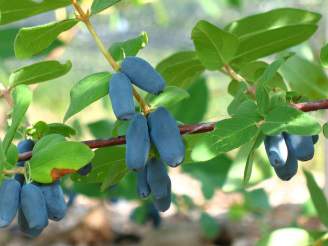Haskaps – Lonicera caerulea
Haskap and Honeyberry Update 2013
Haskaps are a newly developed fruit with an exciting future on the Plains. They are extremely hardy, delicious and able to grow where blueberries fail to thrive. Haskaps can be used just like blueberries but grow well in many soil types, even those near pH 8. Winter temperatures of -40°F do not affect them and flowers can withstand 17°F and still produce fruit.
History: Haskaps are the name for a type of ‘Edible Blue Honeysuckle’. This name is one of several that have been attributed to the native Ainu people of the northern islands of Japan. The North American breeders of these plants have developed a convention to call selections with Japanese ancestry by the name ‘haskap’. Selections brought here from Russian lands are called ‘honeyberries’, a term coined by Mr. Jim Gilbert, owner of One Green World Nursery, Ore., when he introduced these cultivars to the US in the 1990s. These plants often have the word ‘Blue’ in their name. “In general, honeyberry refers to Lonicera caerulea L. subspecies kamtshatica, edulis, boczkarnikovae, and, to lesser degree, altaica. Haskap is a name used in Japan and refers to Lonicera caerulea subspecies emphylocalyx. These plants are native to northern regions of Eurasia and North America.” 1
Haskap breeding in North America started with the work of Dr. Maxine Thompson, a retired horticulture researcher from Oregon State University. She acquired Japanese seeds and began breeding plants for the Oregon climate. In the early 2000s, Dr. Bob Bors, University of Saskatchewan-Saskatoon, started acquiring Russian/Siberian type cultivars. He also visited Dr. Thompson in 2005 to help evaluate her selections and brought back a large collection of Japanese material for testing and breeding work.
The Canadian breeding program began with about 3,600 seedlings and further 4-5,000 seedlings were added to the program each year. With great luck, two named cultivars and three numbered selections were released to Canadian propagators in 2007. In 2010, agreements were reached and propagators were able to sell plants to interested growers in the US. Work continues on advanced selections and selections of quality pollinizers.
It seems within reason to say that millions of haskaps are being planted in Canada’s Prairie Provinces. Dr. Bors and the University of Saskatchewan-Saskatoon horticulture department have been working with businesses in Japan to develop the fruit and a relationship between Japanese processors and Canadian growers. In Japan, the fruit is seen as very traditional, healthful and desirable. Yet due to the loss of farmers and land, less is grown each year.

The Russian types, for the most part, need consistent cold weather, like we have in North Dakota. The Japanese types are more flexible; they do well in the fluctuating winter temperatures of Oregon and they do well in very cold areas. I don’t think that any of these plants do well in warmer parts of the continent as they have chilling requirements that need to be met each winter.
Plant young, small plants 1-3 inches deeper than they came. If dormant, prune back any long shoots to 2-3 inches. Like all young plants, mulch them and keep them moist but not wet. The next spring, if you feel the plant is not branched enough, prune it back again. The plant should then develop a flush of new growth. If you have just a few plants, you might circle the new growth with a bit of twine to support the soft, new branches. They can break off in the wind when they are tender but will harden up by late summer.
You should get berries in the third and following years provided you have planted at least two different, compatible, plants that provide pollen for each other. Berries won’t be truly ripe for 2 to 3 weeks after they turn blue. You will need to protect them from birds during this period. Taste the berries. Harvest them by plucking or shaking the branches over a sheet. Roll the harvested berries over an inclined terry towel to remove rough bits. Freeze and enjoy as long as they last.
--History information is derived from published material at www.fruit.usask.ca
- Danny L. Barney, Ph.D., Haskaps and Honeyberries. Professor of Horticulture, Superintendent, University of Idaho SandpointResearch & Extension Center.


